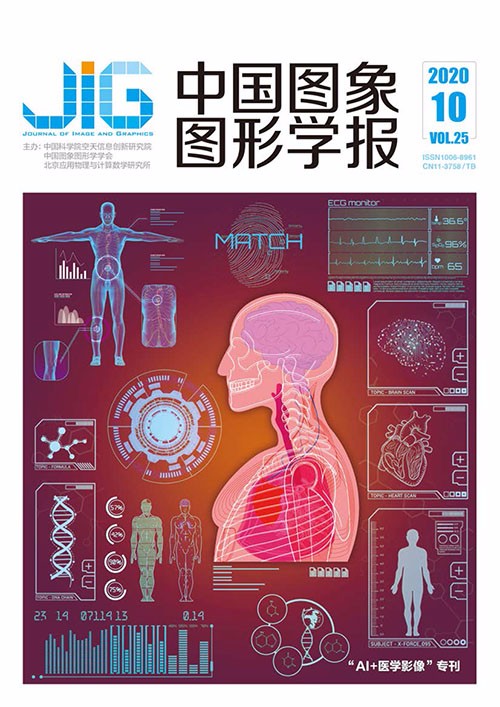
高分辨率深度生成网络的缺失牙体形态设计
郭闯1, 戴宁1, 田素坤1, 孙玉春2, 俞青3, 刘浩1, 程筱胜1(1.南京航空航天大学机电学院, 南京 210016;2.北京大学口腔医学院修复科, 北京 100081;3.南京市口腔医院口腔修复科, 南京 210008) 摘 要
目的 针对口腔修复体设计中采用标准牙数据库进行再设计时未考虑缺失牙多样性以及个性化程度不足的问题,提出基于高分辨生成式对抗网络(high resolution generative adversarial network,HRGAN)的缺失牙冠个性化设计方法。方法 首先,利用图像熵的多方向正交投影方法计算牙体的深度距离值,并构建出咬合面、舌侧面和颊侧面的具有像素值增强的高分辨率深度图像数据集;其次,通过构建的HRGAN模型合成具有高分辨率的缺失牙深度图像,并采用像素—距离的映射关系得到缺失牙齿的3维点云数据;最后,采用点云配准技术和网格重建方法完成3组点云的拼接及3维牙冠形态重建。结果 实验采用500副牙冠模型进行训练和测试,通过设置不同损失条件的实验,与不同方法进行比较分析设计牙冠与目标牙冠的偏差。与计算机辅助设计(computer aided design,CAD)方法和基于生成模型的设计方法对比得出,本文构建的HRGAN模型生成的牙冠形态的标准偏差相比前两者分别降低了21.2%和7%,均方根值(root mean square,RMS)分别下降了43.8%和9.8%,并且牙冠咬合面形态与专家设计牙冠形态最为接近。结论 本文提出的基于高分辨率生成网络的牙体设计方法能够有效地完成缺失牙体的形态设计,设计的牙冠具有天然牙解剖形态特征。
关键词
Morphological design of missing tooth driven by high-resolution deep generation network
Guo Chuang1, Dai Ning1, Tian Sukun1, Sun Yuchun2, Yu Qing3, Liu Hao1, Cheng Xiaosheng1(1.College of Mechanical and Electrical Engineering, Nanjing University of Aeronautics and Astronautics, Nanjing 210016, China;2.Department of Prosthodontics, Peking University School and Hospital of Stomatology, Beijing 100081, China;3.Department of Prosthodontics, Nanjing Stomatological Hospital, Nanjing 210008, China) Abstract
Objective Dental defect is a common problem in oral restoration treatment. For the symptoms of severe tooth loss, the traditional clinical treatment method is porcelain tooth restoration. This method primarily relies on the experience and technology of physicians and experts. Given the long time, this method leads to restoration precision is not easy to control. The current restoration method is to use the dental restoration computer aided design/computer aided manufacturing(CAD/CAM) system for restoration treatment. For example, in the CAD design of full-crown restorations, most methods use the standard tooth model in the standard database as the initial model to replace the defective tooth. A series of algorithms are used to properly deform the crown mesh model to reconstruct the target full-crown restoration model. This method uses the standard tooth model, lacks personalization, and requires a large number of man-machines in the design process. With regard to the interactive operation, the operator's technical experience is required, and the design contains a large degree of subjectivity. A personalized design method for the missing tooth crown based on the generative adversarial networks (HRGAN) is proposed to solve the personalized design of complex tooth morphology. Method Given the powerful processing ability of the HRGAN on the image, the three-dimensional model is reduced to a two-dimensional image, and the network can learn it. First, the depth distance of the tooth is calculated by using the multi-direction orthogonal projection method, and the high-resolution depth images of the occlusal surface, lingual side, and buccal side were constructed. The quality of the tooth image is optimized by the method of pixel value enhancement to subsequently use the generative confrontation network and better fit the morphological distribution of the crown. Image entropy describes the richness of the information carried by the image. Image entropy is used to evaluate the constructed depth image and construct a batch of learning data sets suitable for deep convolutional networks. Then, based on the multi-scale generative and discriminant models, the structure of the missing tooth restoration network model is constructed. The generative model generates the crown data by capturing the distribution of the crown data. The discriminant model is used to determine whether a sample is from expert design data rather than generated data. The two models are trained alternately and iteratively, playing with each other and constantly optimizing. The network merges a feature-matching loss on the basis of the discriminator to better fit the morphological features of the teeth and adds a perceptual loss to enhance network's ability to reconstruct the shape of the occlusal surface of the tooth. Finally, the point cloud data of the crown are calculated on the basis of the gray value and distance value mapping, and the rough registration is performed according to the information of the missing crown in the adjacent tooth. The iterative closest point algorithm is used to precisely register the generated crown point cloud with the original point cloud and achieve the reconstruction of the missing tooth model. Result We have constructed 500 sets of tooth depth map data, of which 400 sets are used as training sets and 100 sets are used as verification sets. The quality of the network-generated image is evaluated by the similarity between the tooth image synthesized from the HRGAN and the image obtained from the expert-designed tooth under experiments with different loss conditions. By calculating the peak signal to noise ratio(PSNR) and structrual similarity(SSIM) values of the two groups of images, the similarity between the images generated by the network and the image designed by the expert is improved after adding the loss of feature matching and perception, and the reconstructed occlusal surface of the crown has rich features of tooth pits and sulcus. The deviation analysis of the reconstructed occlusal surface and its corresponding expert design crown is carried out. The results show that compared with the CAD design method and the generative model-based design method, the standard deviation of the crown shape generated by the method in this paper is 21.2% and 7% lower than the former two methods, and the root mean square(RMS) value is 43.8% and 9.8% lower, respectively, and the shape of the occlusal surface of the crown is the closest to the shape of the expert-designed crown. Conclusion The experimental results show that the tooth design method based on the high-resolution generation network proposed in this paper can effectively complete the morphological design of the missing tooth, and the designed crown has enough natural tooth anatomical morphological characteristics.
Keywords
full crown restoration generative adversarial network(GAN) image synthesis point cloud registration tooth shape design
|



 中国图象图形学报 │ 京ICP备05080539号-4 │ 本系统由
中国图象图形学报 │ 京ICP备05080539号-4 │ 本系统由